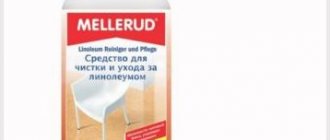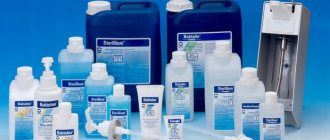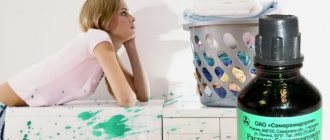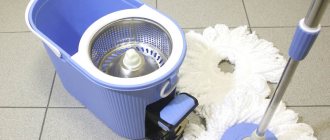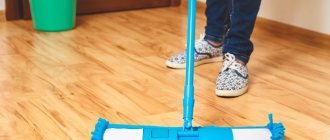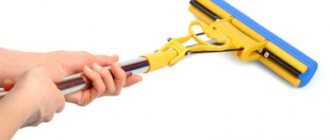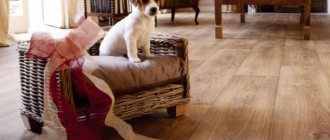Mastic for linoleum may differ in composition, color and quality. In order for linoleum to lay well, you will need a special mastic for linoleum, which you can purchase at a building materials store or make it yourself. This product allows you to achieve ideal evenness of the floor; in addition, the floor covering will be less subject to abrasion and deformation from shoes and when moving furniture.
Mastic for laying linoleum
Mastic should be purchased after the type of linoleum has been selected; the composition of the base is no less important.
At home, you can make your own mixture by mixing ingredients such as:
- Wax;
- Petrol;
- Paraffin;
- Rosin.
When purchasing mastic for linoleum, you should examine its composition for the presence of harmful substances.
First, rosin is melted over a fire, and then wax and paraffin are added. After half a minute, turning off the heat, add gasoline and mix well. After cooling, the product is ready for use.
A small layer of mastic of 5 mm is applied to the prepared base, cleaned of dust and debris. It is better to do this with a special notched spatula, so the product will be used more economically. The layer should be uniform over the entire area of the room.
After laying the coating, you need to properly press the material to the surface. You can use a roller for this. During the day, it is advisable not to walk on the linoleum and wait until it is completely glued.
When purchasing the composition in a store, be sure to look at the expiration date, and also consult which mastic is suitable for the base of the floor. You need to know at what temperature you need to use the product and how long to keep it. Exposure time may vary between mixtures.
What can't you clean it with?
First, let’s put aside the products that are not suitable for linoleum.
, For example:
- Avoid hot water immediately. It can make him swell.
- Often housewives, sharing their experience, recommend using soda. And put it aside. The alkali contained in this product causes damage to the surface over time. Baking soda is more suitable for dishes with a smooth structure.
- Abrasive products scratch it.
- Solvents and bleaches, which we sometimes use to remove stains, will discolor the design, and in severe cases can leave a corroded stain, all the way to the base.
It turns out that everything is not so simple, I wiped it with a rag and forgot. Any thing requires proper care, linoleum is no exception. After we have put the substances that are harmful in our case into the drawer, let’s think about what can be used.
Proper cleaning of linoleum
Regular cleaning of the floor covering is necessary, as it allows you to maintain the attractive appearance of linoleum and increases its service life.
Linoleum has its disadvantages, such as:
- Susceptibility to mechanical pressure;
- Sensitivity to chemical action;
- Wear of material due to critical differences in low and high temperatures.
In this regard, it must be periodically treated with special means. Cleaning can be done using polish, detergents and polymer-based mastic.
As a result of processing, a protective layer is formed on the surface of the material in the form of a thin but dense film, which preserves the surface structure.
You can clean linoleum using household chemicals.
There are cleaning products that help protect linoleum from exposure:
- Sun rays;
- Significant mechanical load;
- Liquids with different compositions.
They can differ in shade, density, shine or gloss that they impart to the coating.
To prevent the coating from cracking, it is recommended to wipe it up to 2 times a week. To remove the protective layer, just spray the floor with linseed oil or olive oil.
Conclusion
We figured out how to restore the shine of linoleum and protect it from wear and contamination, because polish not only improves the appearance, but also creates a reliable wear-resistant layer. The video in this article will help you understand the issue even better, but if something remains unclear to you, then write your questions in the comments below.
Did you like the article? Subscribe to our Yandex.Zen channel
June 1, 2016
Linoleum, Floor cleaning
If you want to express gratitude, add a clarification or objection, or ask the author something, add a comment or say thank you!
What is the best linoleum cleaner to use?
The most affordable and simple means for washing linoleum is a soap solution prepared from ordinary laundry soap or dishwashing detergent diluted in water.
However, not all stains can be washed off with this composition; it is more suitable for simply refreshing the material. To do this, you only need a mop and water, since you can wipe linoleum without soap.
There is a wide selection at the store, but each detergent is designed for a different purpose.
So there are compositions for:
- Simple, regular washing;
- For washing stains with substances that repel dirt;
- For protective purposes;
- Universal means.
Before purchasing this or that linoleum cleaner, you should read reviews about it on the Internet.
They all have their own composition and certain qualities, so they cannot be mixed in any way.
The main thing is that you need to choose exactly those mixtures that are specifically intended for processing linoleum. You should be careful when powders and solutions contain soda, alkali or acid.
To properly wash linoleum, you must first remove all debris and dust from its surface. To do this, you can use a brush or vacuum cleaner. After laying the new material, it is better not to wash it at all for about 1 month. To sand the floor to a shine, you can only use soft rags or soft brushes; it is best to do this by hand. Restoring linoleum after scratches have appeared on it will take much longer than careful care every day.
Stains are removed using dry powders or ordinary dishwashing liquid if they are greasy. Only after cleaning individual areas is the floor washed completely. Difficult dirt can be removed using kerosene or gasoline.
Consequences of repair
A real panic about how to wash linoleum can overtake any housewife after the renovation of the apartment is completed. It is better to prevent headaches and protect the linoleum covering with old carpet, several layers of newspapers, polyethylene, and large rags. If this has not been done, cleaning will be long, difficult and quite thorough. The algorithm will be like this:
- dry cleaning;
- wet cleaning;
- washing “clean” using vinegar or potassium permanganate;
- drying.
Dry cleaning will consist of sweeping away dust, dirt, construction waste with a broom or brush
Dry cleaning will consist of sweeping away dust, dirt, and construction waste with a broom or brush. If any building compounds have dried to the coating, use a spatula. The next stage is wet cleaning. Here the question of how to clean linoleum floors is quite acute, because the contamination is serious. You should choose a serious professional product exclusively for linoleum: when choosing it, listen to the advice of a store consultant. Get ready for the fact that you will change the water, as well as the rag, several times (at least 3). Only then will you be able to achieve the desired effect. Finally, take clean water again, dissolve vinegar or potassium permanganate in it and wipe the floor clean with a completely new rag.
If you do not want to carry out cleaning work manually, then after dry cleaning, a washing vacuum cleaner for linoleum can greatly help you
Some difficulties may arise in the fight against polyurethane foam. Its top layer should be carefully cut off with a construction or stationery knife. The bottom layer needs to be moistened generously with water and allowed to become limp. The ideal option is to cover the foam marks with a wet cloth for several hours. The swollen mass is more easily washed off with a special means for removing polyurethane foam. If you do not want to carry out cleaning work manually, then after dry cleaning, a washing vacuum cleaner for linoleum can greatly help you. He can actually reduce the number of washes and carry them out with significant savings in time and effort.
At the end, some tips for restoring the former shine to the old linoleum covering. To do this, you can use a folk remedy: milk added to water in a 1:1 ratio or chilled water in which the potatoes were boiled. Afterwards, the linoleum covering should be rubbed with appropriate products to protect and shine it. You can use polymer mastic or polish.
What is linoleum varnish?
In order to update old material, you can use a product such as linoleum varnish.
Special varnish can be produced in the form of polish, mastic or polymer-based wax.
The action that these drugs produce:
- Sanding to achieve a beautiful shine;
- Protection against premature wear;
- Preventing cracks and scratches on linoleum;
- Increasing the service life of the floor covering;
- The surface becomes more antistatic and less slippery.
Thanks to linoleum varnish, you can significantly improve the aesthetic and performance qualities of the floor covering
You can varnish the floor manually using a soft brush or a cloth with soft bristles. This is done after wet cleaning and removing stains. The polish is added to the water.
When the linoleum dries, and this happens within 30 minutes, a transparent layer of film forms on its surface, which provides protection and also adds shine.
For a denser film, you need to repeat this process 2-3 times, then the polymer particles in the form of a film will be the most durable.
There are a large number of special varnishes for linoleum that add shine or gloss to its surface. You can make it matte if desired.
Types of ready-made compounds
Many types of linoleum mastics sold in stores are universal. Only linoleum without a base requires a special composition. However, before purchasing, you need to carefully read the composition and manufacturer’s recommendations. These are mainly rubber-based mastics and are suitable for:
- Relina.
- PVC linoleum.
- Nitrocellulose linoleum.
- Natural linoleum.
Types of polishes for linoleum
Different types of polishes have different functions - the properties of some are aimed at protecting the coating, others - at giving the surface, gloss, shine, reducing static electricity, and, accordingly, slipping.
Characteristics of the species:
- Floor polish enhances shine and gives linoleum a special glossy or matte shine.
- The protective composition helps protect the coating from scratches, cracking, marks from furniture and shoes.
- Polish can effectively repel dirt and remove some defects in linoleum and its unevenness.
- Protective compounds protect the surface from exposure to ultraviolet radiation and yellowing.
Using polish, you can give linoleum newness and shine
All these types can be combined with each other, while observing the application technology. Sometimes, before you start applying any composition, you need to remove a layer of the existing product.
User reviews show that, in general, cleaning, detergents and protective agents, if used as intended, significantly extend the life of linoleum.
If you have doubts about a particular product, you can try its effect by conducting a test on a small piece of material to avoid disappointment in the future.
To clean the surface of the coating after repair, paint stains can be removed using ordinary oil - linseed or sunflower. Any solvent will also work, but this must be done very carefully. A moistened piece of cloth or cotton wool should be applied only to the stain itself, without catching the material around it.
Materials
Linoleum comes in different types. After reading the brief characteristics, it is not difficult to make a choice. Linoleum happens:
- Made from natural materials. This linoleum is made from linseed oil, tree resin and other natural materials. In addition to being environmentally friendly, it is non-flammable, does not absorb fat and is resistant to the growth of microorganisms. These are some pretty serious benefits.
- Made of rubber. Relin (aka rubber linoleum) is moisture resistant and more flexible.
- Made from PVC. The quality and price of such linoleum depend on the substrate and the number of layers. It is warm, but it shrinks a lot and has a specific smell for a very long time. This is not suitable for everyone.
- Alkyd. This type has good sound and heat insulation, but is more fragile than the others. It is not suitable for premises with frequent traffic.
- Made from nitrocellulose. Such a floor will be very beautiful, with a noble shine, but due to the lack of a backing it will be easily flammable.
Casein-emulsion
This type of mastic is used for gluing fabric-based PVC and glyptal linoleum to particle boards, wood fiber boards and hard fiber boards.
Note! When making mastic at home, you must strictly follow fire safety rules. Some ingredients are highly flammable.
The advantages of the adhesive composition include:
- Environmental friendliness;
- Strength;
- Ease of manufacture;
- Low price.
However, this mastic also has one drawback - it can only be used in conditions of air-dry floor operation. If this condition is not met, the coating will quickly peel off. .
Preparation method
To prepare this mastic you will need the following ingredients:
- 18 parts drying oil;
- 18 parts of OB brand casein glue;
- 36 parts water;
- 36 parts limestone flour.
Mastic is made as follows:
- First of all, you need to soak the glue in warm water in a small amount of water, let it swell, then stir well until a homogeneous mass is formed.
- Pour the remaining water into the dissolved glue and leave the mixture for 30 minutes so that the glue completely swells.
- Then pour drying oil into the resulting mixture in a thin stream. Then the contents of the dish must be mixed until a homogeneous emulsion is obtained.
- Next, add limestone flour in small portions.
Storage and use
This mastic cannot be stored for a long time, so it must be used up within 4-5 hours. If you need to perform a large amount of work, it is better to produce it in small portions.
The consumption of casein-emulsion mastic is one and a half to two kilograms per square meter of base.
Bisky
Biski mastic for gluing linoleum, which is a black viscous mass, has become widely popular. It can be used when laying polyvinyl chloride and glyphthalic linoleum on a fabric basis.
“Biskey” is not difficult to buy at almost any hardware store.
Its advantages include the following properties:
- Non-flammable;
- Absolutely harmless;
- Provides reliable adhesion of linoleum;
- Not difficult to make at home.
Cooking method
To prepare Bisque you will need the following ingredients:
- 65% bitumen BN-IV;
- 4% turpentine;
- 22% white spirit;
- 7% Portland cement;
- 2% rubber cement.
The manufacturing instructions are as follows:
- Large dishes must be filled two-thirds with bitumen, heated over a fire and brought to a temperature of 150 degrees, i.e. until completely melted.
- Then you need to remove all impurities and slightly cool the bitumen.
- After this, the contents of the container are thoroughly stirred and cement is added.
- Next, the contents should be cooled to a temperature of 70-80 degrees Celsius and turpentine and white spirit should be poured in a thin stream. In this case, the mixture must be constantly stirred.
- Lastly, you need to add rubber glue.
Storage
The Biski adhesive mixture can be stored for quite a long time, but no more than three months, provided that tightly closed containers are used. Three months after preparation, it thickens, after which it can no longer be used.
Note! Approximately one kilogram of mastic is consumed per square meter of floor.

